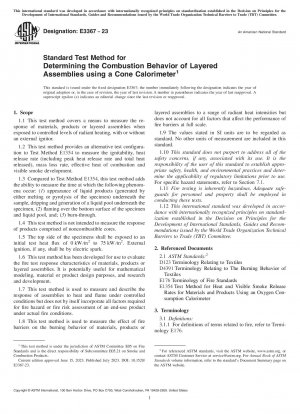ASTM E3367-23
Standard Test Method for Determining the Combustion Behavior of Layered Assemblies using a Cone Calorimeter
- Standard No.
- ASTM E3367-23
- Release Date
- 2023
- Published By
- American Society for Testing and Materials (ASTM)
- Latest
- ASTM E3367-23
- Scope
- 1.1 This test method covers a means to measure the response of materials, products or layered assemblies when exposed to controlled levels of radiant heating, with or without an external ignitor. 1.2 This test method provides an alternative test configuration to Test Method E1354 to measure the ignitability, heat release rate (including peak heat release rate and total heat released), mass loss rate, effective heat of combustion and visible smoke development. 1.3 Compared to Test Method E1354, this test method adds the ability to measure the time at which the following phenomena occur: (1) appearance of liquid products (generated by either melting or pyrolysis of the specimen) underneath the sample, dripping and generation of a liquid pool underneath the specimen, (2) flaming over the bottom surface of the specimen and liquid pool, and; (3) burn-through. 1.4 This test method is not intended to measure the response of products comprised of noncombustible cores. 1.5 The top side of the specimens shall be exposed to an initial test heat flux of 0 kW ⁄m2 to 75 kW ⁄m2 . External ignition, if any, shall be by electric spark. 1.6 This test method has been developed for use to evaluate the fire test response characteristics of materials, products or layered assemblies. It is potentially useful for mathematical modeling, material or product design purposes, and research and development. 1.7 This test method is used to measure and describe the response of assemblies to heat and flame under controlled conditions but does not by itself incorporate all factors required for fire hazard or fire risk assessment of an end-use product under actual fire conditions. 1.8 This test method is used to measure the effect of fire barriers on the burning behavior of materials, products or layered assemblies to a range of radiant heat intensities but does not account for all factors that affect the performance of fire barriers at full scale. 1.9 The values stated in SI units are to be regarded as standard. No other units of measurement are included in this standard. 1.10 This standard does not purport to address all of the safety concerns, if any, associated with its use. It is the responsibility of the user of this standard to establish appropriate safety, health, and environmental practices and determine the applicability of regulatory limitations prior to use. For specific hazard statements, refer to Section 7.1. 1.11 Fire testing is inherently hazardous. Adequate safeguards for personnel and property shall be employed in conducting these tests. 1.12 This international standard was developed in accordance with internationally recognized principles on standardization established in the Decision on Principles for the Development of International Standards, Guides and Recommendations issued by the World Trade Organization Technical Barriers to Trade (TBT) Committee.
ASTM E3367-23 Referenced Document
- ASTM D123 Standard Terminology Relating to Textiles*, 2023-09-14 Update
- ASTM D4391 Standard Terminology Relating to The Burning Behavior of Textiles
- ASTM E1354 Standard Test Method for Heat and Visible Smoke Release Rates for Materials and Products Using an Oxygen Consumption Calorimeter
- ASTM E176 Standard Terminology of Fire Standards
ASTM E3367-23 history
- 2023 ASTM E3367-23 Standard Test Method for Determining the Combustion Behavior of Layered Assemblies using a Cone Calorimeter
